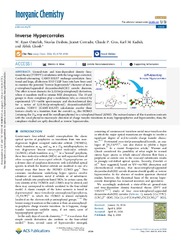Inverse Hypercorroles
Permanent link
https://hdl.handle.net/10037/35093Date
2024-05-02Type
Journal articleTidsskriftartikkel
Author
Osterloh, W. Ryan; Desbois, Nicolas; Conradie, Jeanet; Gros, Claude P.; Kadish, Karl M.; Ghosh, AbhikAbstract
Ground-state and time-dependent density functional theory (TDDFT) calculations with the long-range-corrected, Coulomb-attenuating CAMY-B3LYP exchange-correlation functional and large, all-electron STO-TZ2P basis sets have been used to examine the potential “inverse hypercorrole” character of meso-p-nitrophenyl-appended dicyanidocobalt(III) corrole dianions. The effect is most dramatic for 5,15-bis(p-nitrophenyl) derivatives, where it manifests itself in intense NIR absorptions. The 10-aryl groups in these complexes play a modulatory role, as evinced by experimental UV–visible spectroscopic and electrochemical data for a series of 5,15-bis(p-nitrophenyl) dicyanidocobalt(III) corroles. TDDFT (CAMY-B3LYP) calculations ascribe these features clearly to a transition from the corrole’s a2u-like HOMO (retaining the D4h irrep used for metalloporphyrins) to a nitrophenyl-based LUMO. The outward nature of this transition contrasts with the usual phenyl-to-macrocycle direction of charge transfer transitions in many hyperporphyrins and hypercorroles; thus, the complexes studied are aptly described as inverse hypercorroles.
Citation
Osterloh, Desbois, Conradie, Gros, Kadish, Ghosh. Inverse Hypercorroles. Inorganic Chemistry. 2024Metadata
Show full item recordCollections
Copyright 2024 The Author(s)


 English
English norsk
norsk
